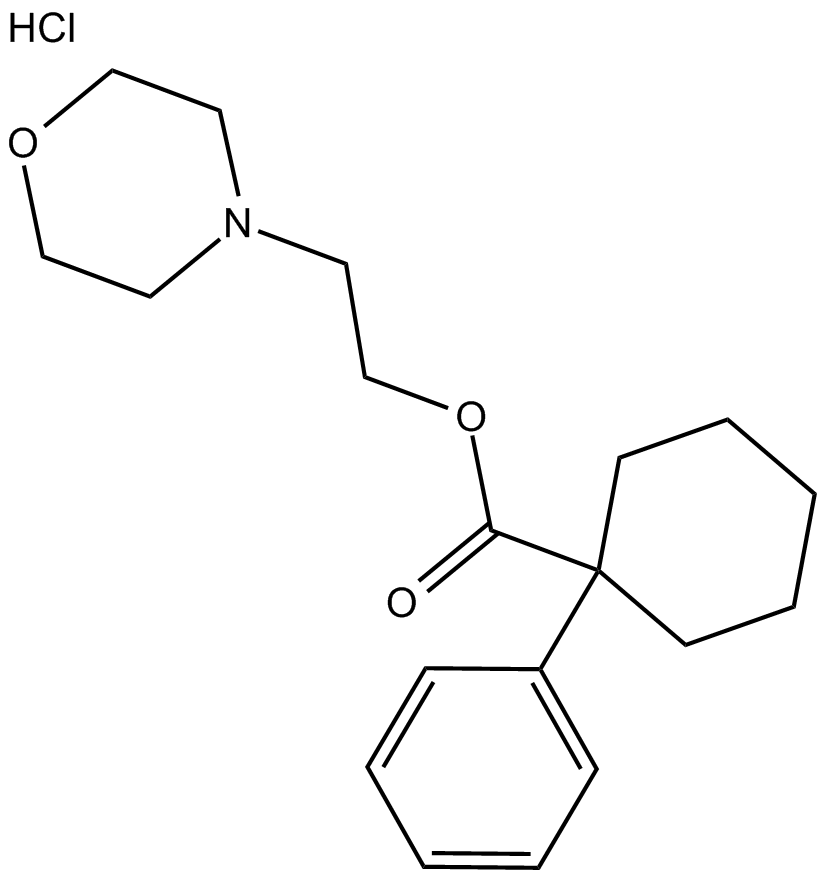PRE-084 hydrochloride |
| Catalog No.GC14960 |
El clorhidrato de PRE-084 es un agonista del receptor σ1 (S1R) altamente selectivo, con una IC50 de 44 nM.
Products are for research use only. Not for human use. We do not sell to patients.

Cas No.: 75136-54-8
Sample solution is provided at 25 µL, 10mM.
Ki: 2.2 and 13091 nM for σ1 and σ2 receptors respectively.
PRE-084 hydrochloride is a selective σ1 agonist with high affinity, rather than over PCP receptors (IC50 > 100000 nM) and several other receptor systems. It was reported that sigma (s) receptor ligands to alleviate learning and memory impairments on several pharmacological and pathological rodent models of amnesia, involving the s1 subtype of s receptor.
In vitro: PRE-084 had an IC50 of 44 nM in the receptor assay and an IC50 of more than 100,000 nM for PCP receptors and an IC50 higher than 1 0,000 nM in many other receptor systems. In general, hydroxy-substituted phenyl groups in these compounds like PRE-084 tended to have attenuated potency at a receptors, whereas methylphenyl and chlorophenyl substitutions enhanced potencies. Reduction of cycloalkyl ring size lowered potencies for a receptors and quatemized amine groups invariably decreased the compound’s potencies. [1]. The Sig-1R agonist PRE084 not only increases cell survival, but also counteracts the deleterious effects caused by NMHP in neuronal PC6.3 cells. Particularly, PRE084 stimulates the NF-kB pathway that is compromised by the expression of mutant huntingtin proteins, increasing the levels of cellular antioxidants. These data show that the Sig-1R agonist beneficially effects on models of HD and that compounds binding the Sig-1R may be potent targets for future drug development in HD [2].
In vivo: After exposure to CO or 14 days after intoxication with trimethyltin, the spontaneous alternation deficits was reversed significantly by the selective sigma1 ligand PRE-084 (1 mg kg-1) [3]. Administration of Pre-084 (5 mg/kg, i.p.) inhibited citric-acid-induced cough in guinea-pigs. In addition, when administered by aerosol, sigma agonist Pre-084 (1 mg/ml) inhibited cough [4].
Clinical trial: So far, no clinical study has been conducted.
References:
[1]. Su TP, Wu XZ, Cone EJ, Shukla K, Gund TM, Dodge AL, Parish DW. Sigma compounds derived from phencyclidine: identification of PRE-084, a new, selective sigma ligand. J Pharmacol Exp Ther. 1991 Nov;259(2):543-50.
[2]. Hyrskyluoto A, Pulli I, Trnqvist K, Ho TH, Korhonen L, Lindholm D. Sigma-1 receptor agonist PRE084 is protective against mutant huntingtin-induced cell degeneration: involvement of calpastatin and the NF-κB pathway. Cell Death Dis. 2013 May 23; 4:e646.
[3]. Maurice T, Phan VL, Noda Y, Yamada K, Privat A, Nabeshima T. The attenuation of learning impairments induced after exposure to CO or trimethyltin in mice by sigma (sigma) receptor ligands involves both sigma1 and sigma2 sites. Br J Pharmacol. 1999 May; 127(2):335-42.
[4]. Brown C, Fezoui M, Selig WM, Schwartz CE, Ellis JL. Antitussive activity of sigma-1 receptor agonists in the guinea-pig. Br J Pharmacol. 2004 Jan; 141(2):233-40. Epub 2003 Dec 22.
Average Rating: 5 (Based on Reviews and 8 reference(s) in Google Scholar.)
GLPBIO products are for RESEARCH USE ONLY. Please make sure your review or question is research based.
Required fields are marked with *




















